By the early 1960s, the “Tiki Wave” had washed across the face of the continental U.S. But for just a moment, let’s rewind just a few years… When Disneyland opened in Anaheim, California in 1955, it was a park born of its time. Long before Disneyland shaped pop culture, it was shaped by it, with its themed lands attuned to the collective consciousness of mid-century America.
And at that time, a decade of films and radio shows had made the deep, uncharted jungles of Africa into the shared imagery of “adventure” in Americans’ collective consciousness. Fittingly, Walt’s 1955 Adventureland followed suit, bringing to life a remote jungle outpost that would resonate with audiences who associated the genre with the big screen exploits of Tarzan, The Naked Jungle, King Solomon’s Mine, and The African Queen.
A Taste of the Tropics (1955 – 1962)
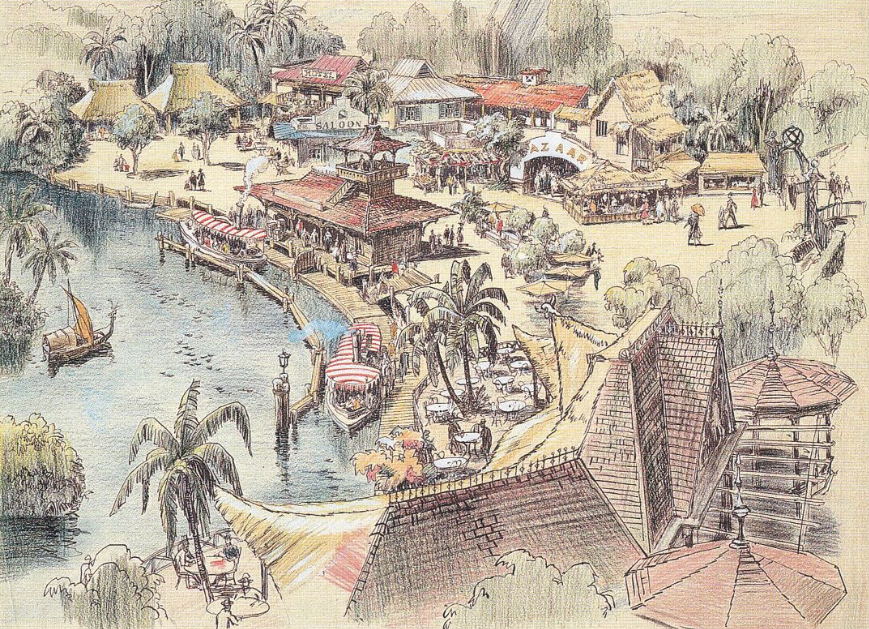
In 1955, only an incidental pocket of Adventureland was stylized with anything deliberately reflective of the South Seas – a Hawaiian patio cleverly acting as expanded seating for the Main-Street-facing Plaza Pavilion Restaurant (above). (To this day, eagle-eyed guests can spot the line where the restaurant’s Victorian shingled roof blinks out of existence, replaced with a thatched-straw roof reflective of Pacific Islands iconography – one of a million charmingly naive thematic “clashes” written into Disneyland’s DNA.)
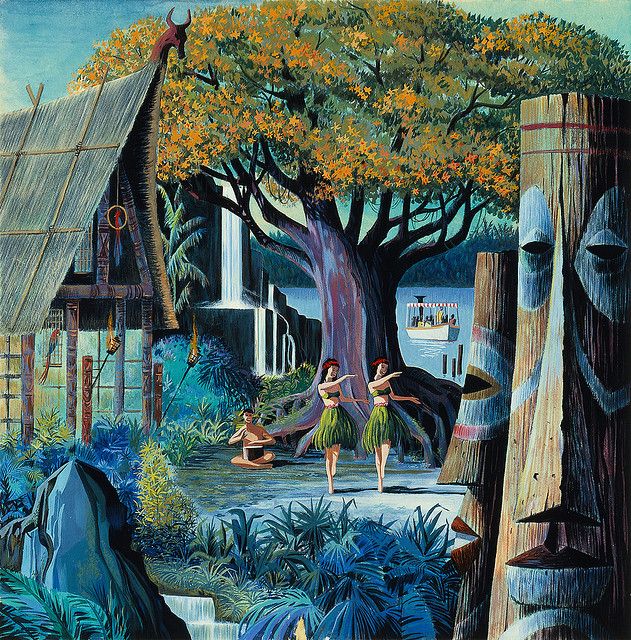
Sixty years after James Dole’s arrival there, though, Hawaii’s official statehood, the rise of passenger air travel, and the same start of the middle class that had sparked Disneyland had caused a pop culture tidal wave that rippled across the country. Suffice it to say that by the close of the decade, “adventure” had changed. Now, Americans’ shared imagery of “adventure” was 11,000 miles from the uncharted jungles of the Congo in the brand new state of Hawai’i. That meant that it was time for Adventureland to change, too.
In the early 1960s, construction began on a new complex that would replace the Plaza Pavilion’s jungle-front “back patio” with a proper tribute to Polynesia and the exotic adventures that could await there. Wedged between the entrance to Adventureland and the Jungle Cruise, longtime park sponsor Stouffer’s (yes, purveyors of fine frozen foods) planned to present two new restaurants, joining (and sharing a kitchen with) their own Plaza Pavilion.
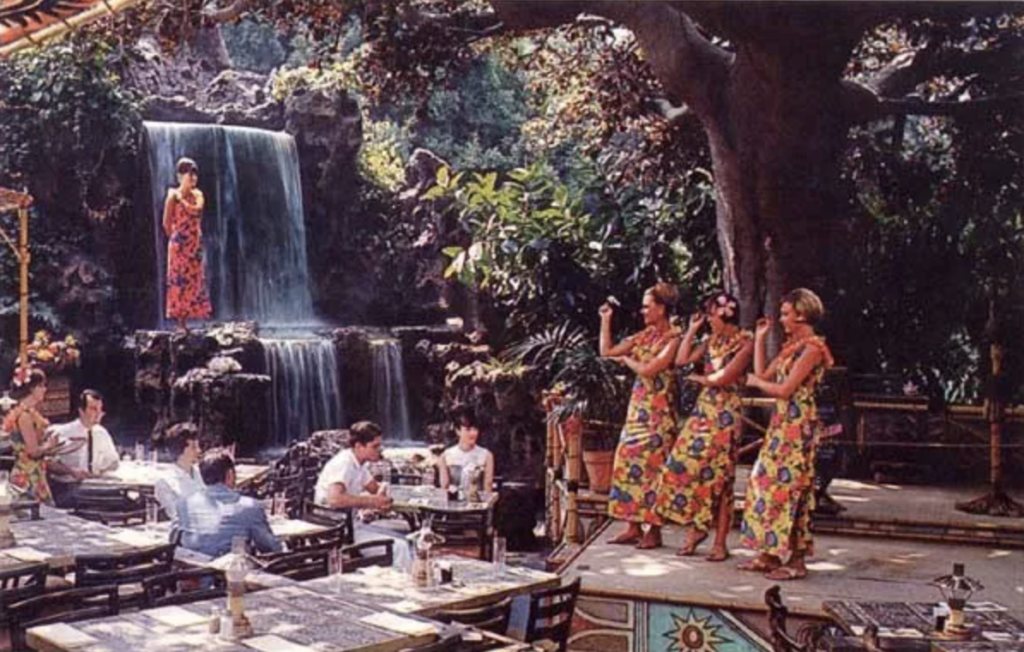
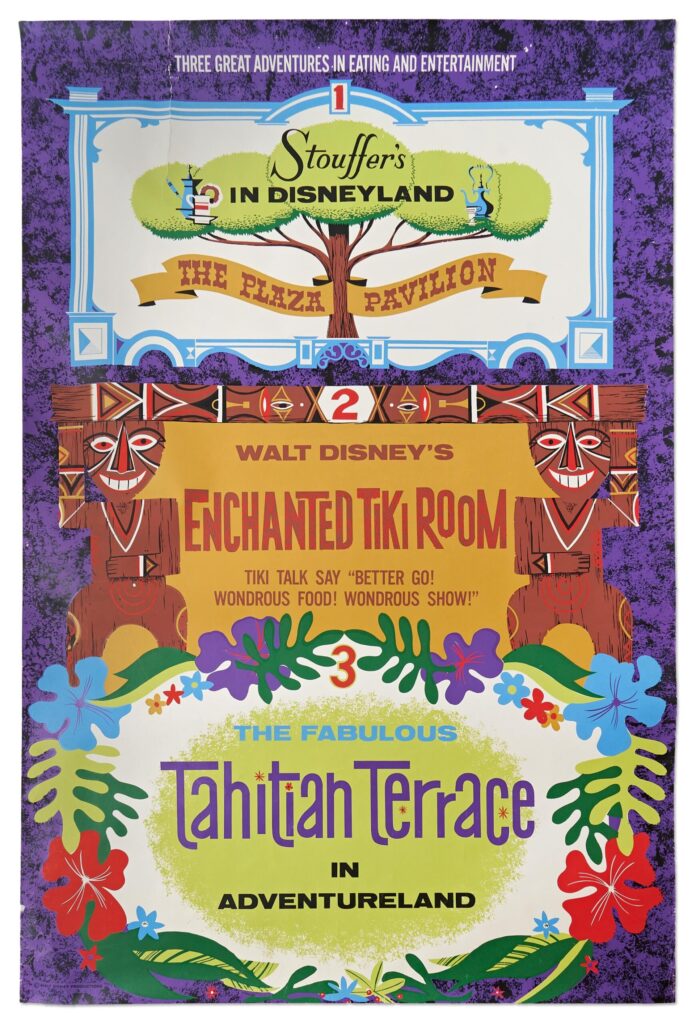
Stouffers’ first new offering opened in 1962. The Tahitian Terrace was Disneyland’s first dinner theater – an entirely outdoor, terraced patio built into a volcanic grotto, protected beneath the canopy of an artificial 35-foot tall tree and surrounded in ever-blooming tropical flowers. During summer months, lines were known to wrap throughout Adventureland as guests eagerly vied for the chance at a table, where they’d receive their own floral leis and secure a sought-after taste of the tropics.
According to Sam Gennaway’s essential The Disneyland Story, guests could order exotic South Seas foods, including “sizzling teriyaki steak, savory shrimp tempura, fried almonds in rich egg batter, and raisin ice cream topped with flaming caramel sauce,” sipping a signature tropical punch served with faux floral garnish. But that wasn’t all. At each performance, a “magical” waterfall would part to allow hula dancers, fire walkers, and the Royal Tahitian dance troupe to enter, dazzling guests with signature song and dance. A lovingly “authentic” showcase of the romance and wonder of the tropics, the Tahitian Terrace was more than a restaurant; it was dinner and a show.
Believe it or not, that was also the plan for the second Stouffer’s sponsored restaurant to be added to Adventureland… But early advertisements’ promise of “Wondrous food! Wonderous show!” ended up being only half true of the Enchanted Tiki Room…
“Sing like the birdies sing” (1963)

As the popular story goes, Walt Disney himself was thrown for a loop when Disney Legend and Imagineer John Hench first suggested the idea of a restaurant filled with tropical birds roosting over the heads of guests. “I’m not so sure about this idea, John,” he reportedly said. “The birds will be pooping on the food!”
Of course, Hench hadn’t planned on having real birds – or worse to Walt’s thinking, stuffed ones – at all. Instead, Disneyland’s Tiki restaurant concept would feature birds brought to life through a then-revolutionary technology under development at WED Enterprises: Audio-Animatronics. The first ever robotics figures capable of being individually programmed to perform to synchronized audio, the field of “3D animation” was so new and novel, it would be a surefire hit… and a huge draw for Disney’s new Hawaiian mini-land.


Ultimately, Walt and his team decided against opening the Tiki Room as a restaurant (fearing that guests would linger too long to take in the musical show). And that’s where today’s tale overlaps with another: our in-depth history of the Modern Marvel: The Enchanted Tiki Room. Consider that tropical legend a fitting “midquel” to the Dole Whip’s – totally worth a side trip into the Park Lore rabbit hole! After all, it’s not just that the Enchanted Tiki Room served as the first ever use of Audio-Animatronics. It’s that the Enchanted Tiki Room was (and remains!) a practically-perfect example of what Disney does best. Residing precisely in the Venn diagram overlap of mechanics, music, and magic, the attraction is still one of Imagineering’s best ever, convincing generations of guests that they’d truly stepped into a magical aviary “where the birds sing words and the flowers croon.”
So you have to imagine what an inexplicable and impossible sensation The Enchanted Tiki Room was in 1963. To lend some context for the unthinkable attraction that awaited within, a single Audio-Animatronic was initially perched outside the Tiki Room but needed to be removed when crowds gathered to gawk at the unbelievable creature, clogging the entrance to Adventureland.
Consider, too, that in 1963, the Enchanted Tiki Room was the only attraction in the park “too good” for even the most expensive and limited ride coupon, an E-Ticket. Instead, guests needed to hand over 75¢ cash – the equivalent of about $6 per person today – to see the show.

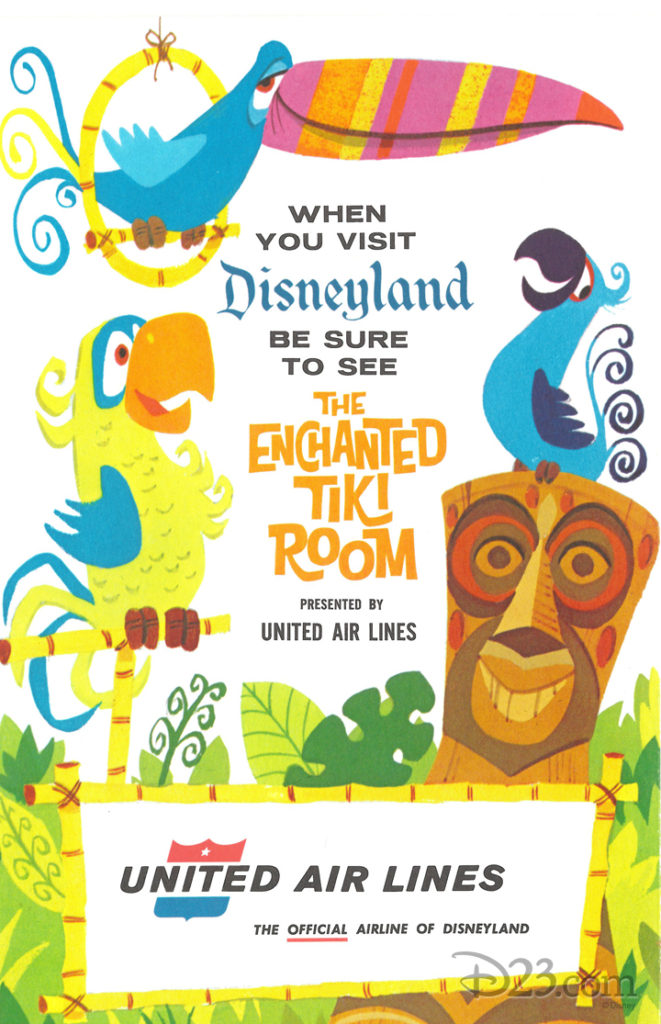
Unsurprisingly, the Enchanted Tiki Room offered a substantial opportunity for corporate sponsorship… Surely, a company with ties to the Islands would leap at the chance to have their name, brand, and messaging incorporated into Disneyland’s brand new beyond-E-Ticket tribute to the enchantment of Hawai’i… Nope, not Dole. At least, not yet…
In 1963, the Enchanted Tiki Room was sponsored by another company looking to build up its association with Hawai’i: United Air Lines. Buoyed by the same Tiki Craze that had created the Tiki Room, United’s service to Honolulu had increased from an average of 2,100 people per month in 1947 to upwards of 33,000 passengers per month in 1964. Hawai’i was truly the new vacation hotspot, and the opportunity for United to sell its services and good will to Disneyland guests was a downright obvious partnership.
For their part, United must’ve also been happy to oversee the 1968 addition of the Tiki Juice Bar, set along the gateway bridge into Disneyand’s Adventureland. It was exactly what its name implied: a juice bar, serving pineapple spears and refreshing, “exotic” tropical juices and punches – a perfect refresher to enjoy during the 17 minute South Seas singalong. That unassuming little thatch-roofed hut may not have looked like an anchor experience of Disneyland in 1968, but give it a new sponsor and a few years and some magic happened…
From Tiki Birds to Orange Bird (1971)
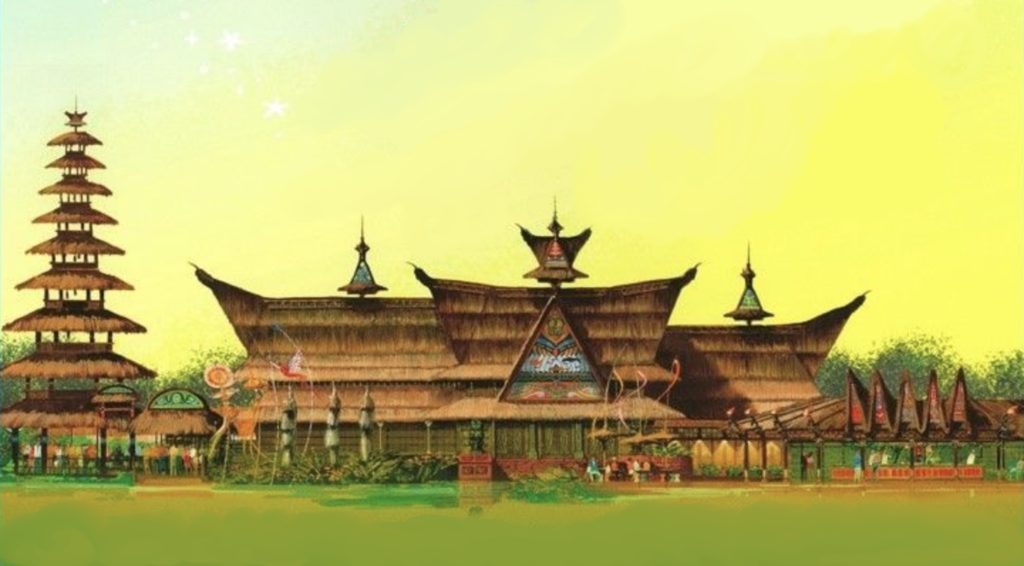
By the mid-1960s, concept work already well underway on what would become Magic Kingdom. Given the success of the Enchanted Tiki Room at Disneyland, it had been clear that Polynesia would be a central focus of the resort’s Adventureland (and earn its own hotel – Disney’s Polynesian Village Resort). That meant that the Tiki Room would be one of many Disneyland essentials to be duplicated in Florida, albeit upsized and adjusted. Disney’s ode to the land of pineapple would come to the land of oranges.
In 1967 – with United still footing the bill in California – Disney signed on a sponsor for the Orlando version: the Florida Citrus Growers. In exchange for sponsorship, Disney had artist Don McLaughlin design a character to be used in the Florida Citrus Commission’s marketing and in association with Disney World: The Orange Bird.
A rare character created just for the parks, the Orange Bird came to be in 1970, establishing himself as both an ambassador to Walt Disney World, a complement to the Tropical Serenade, and a nationwide marketing mascot for Florida oranges. Talk about a win-win-win! In fact, a full decade before Epcot’s Figment would do the same, the Orange Bird became something of an icon in his own right, earning his own walkaround character, merchandise, and commercials.


The character even inspired a 1971 storybook and record. Park Lore Members can stream and singalong to the infectious and melodic rhythm of the Sherman Brothers’ “The Orange Bird Song” (performed by noted homophobe and “is-she-still-alive?” anti-LGBTQ activist Anita Bryant).
Magic Kingdom finally opened alongside the new Walt Disney World in October 1971. Master-planned into the park’s Adventureland (rather than being wedged in and ret-conned as California’s had been), the Florida copy of the attraction – renamed Tropical Serenade – was given prominent placement in the land and a “weenie” entrance meant to draw guests in from the park’s Central Hub. Inside, the show was much the same… except, of course, for carved pineapples on the central fountain being replaced with oranges.
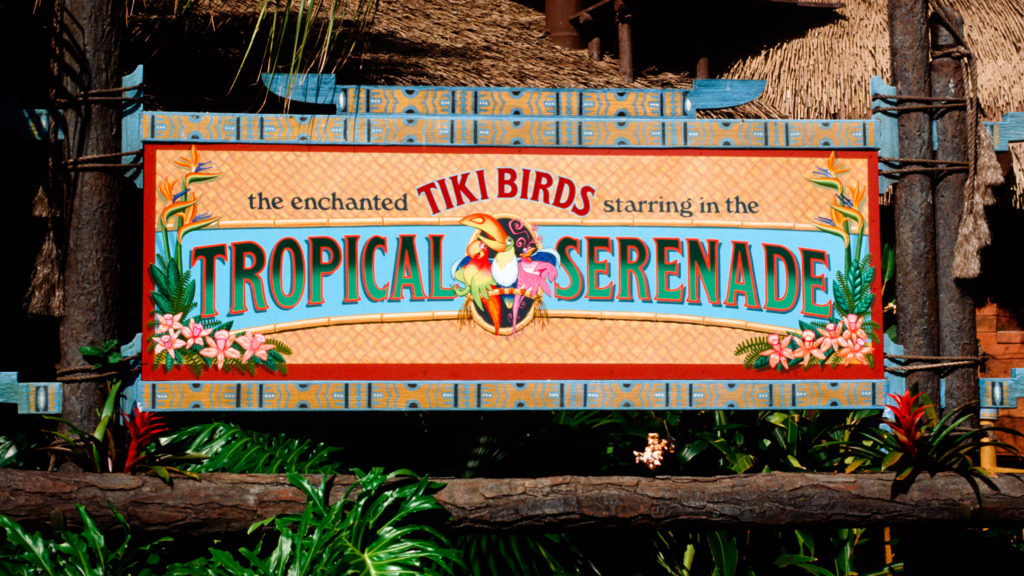
Fittingly, the Tropical Serenade’s attached Sunshine Tree Terrace – Florida’s Juice Bar-equivalent and home base of the Florida Citrus Growers and the Orange Bird – specialized in one thing above all else: fresh, Florida orange juice, of course. But, as it turns out, that’s not all. Among the Florida Citrus Commission’s park-and-property wide fresh orange offerings, Florida’s Tiki Room was the first to offer a swirled tropical treat…



